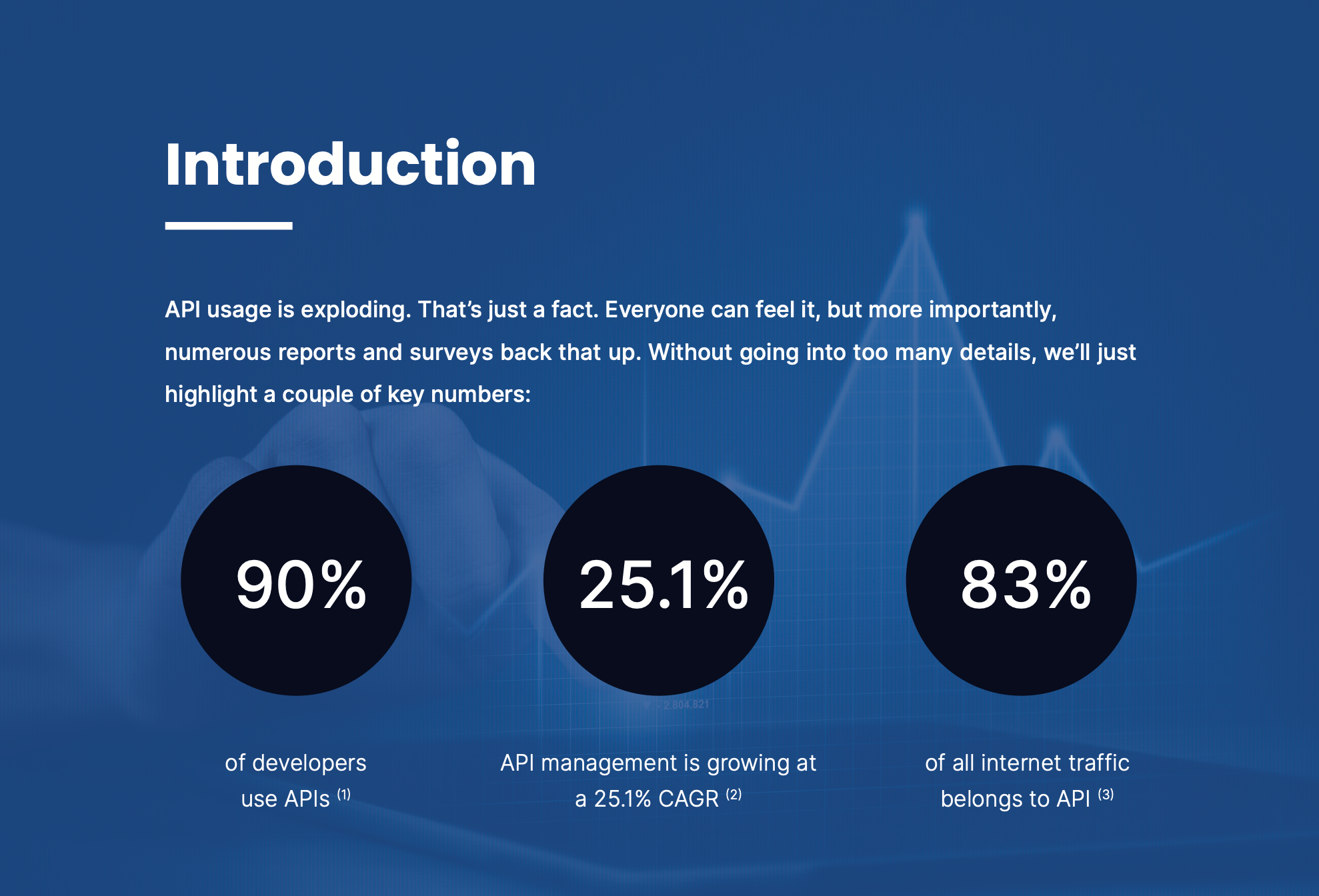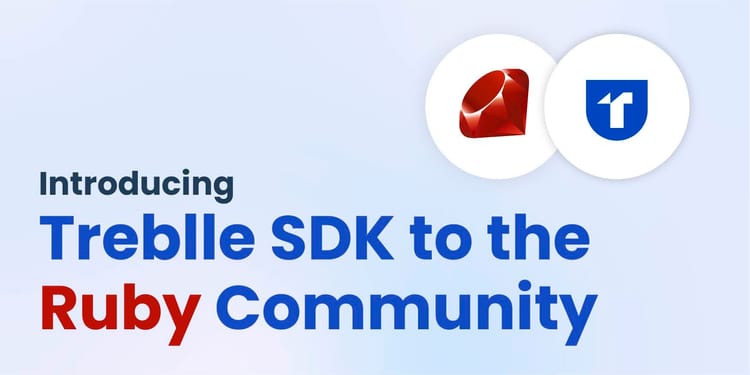🔥 SOME OF OUR HOT FINDINGS:
- AI APIs saw a remarkable 96% growth compared to 2022.
- Surprisingly, 20% of API endpoints remain unused for over 30 days.
- A concerning 51% of requests lack authentication
- 90% of developers are now utilizing APIs
This is blog derived from the "Anatomy of an API, 2023 edition" report by Treblle. The blog highlights and dives into some of the findings. If you want to see the full report you can download it on the link: Anatomy of an API
Exploding API Usage
In today's digital landscape, APIs (Application Programming Interfaces) are not just prevalent; they're dominating. A staggering 90% of developers are now utilizing APIs, which speaks volumes about their integral role in modern technology. The API management sector is witnessing a rapid growth, with a compound annual growth rate (CAGR) of 25.1%. Furthermore, APIs account for 83% of all internet traffic, underscoring their critical importance in the digital ecosystem.

APIs: The Backbone of Modern Business
APIs are more than just technical constructs; they're the lifeblood of contemporary companies, enabling them to tap into the vast potential of the digital realm. These tools allow businesses to harness and amplify their existing data by connecting to diverse data sources, enhancing interoperability, spurring innovation, and opening new avenues for revenue generation.
Historical Proof of Success
The trajectory of API investment can be traced back to the early 2000s, with pioneers like Salesforce and Google leading the charge. These early adopters have paved the way for a new breed of companies like Stripe and Twilio, propelling the API economy while creating substantial shareholder value.
Challenges in API Development
Crafting effective APIs is a complex task. The rush to create APIs mirrors the earlier web development boom, where quantity often trumped quality. This report seeks to understand the current state of API design, usage, and performance in 2023.
Treblle: A Comprehensive APIOps Platform
Treblle emerges as a robust solution, offering an end-to-end APIOps platform. It addresses the top three API pain points: visibility and understanding, governance and standardization, and security. With its easy integration and a suite of six core products, Treblle is revolutionizing how businesses approach API development and management.

2023: A Landmark Year for Treblle
This year, Treblle processed over 5 billion API requests across 9000 different APIs. The insights derived from this vast dataset are shaping our understanding of the API landscape.
Key Insights from the 2023 Data:
- AI APIs saw a remarkable 96% growth compared to 2022.
- Wednesdays experience the highest volume of API requests.
- Surprisingly, 20% of API endpoints remain unused for over 30 days.
- A concerning 51% of requests lack authentication, and 55% carry a medium threat level.
- Client-side errors are four times more common than server-side errors in API interactions.

Methodology and Approach
The study employs a quantitative approach, analyzing 1 billion requests from 9,000 different APIs. This method ensures objectivity and precision, leading to reliable and actionable insights.

Understanding API Design and Performance
- The average API boasts 22 endpoints, with a trend towards microservice-oriented architectures.
- GET and POST are the most widely used HTTP methods, indicating a focus on information retrieval.
- The study reveals a substantial presence of "zombie endpoints," which pose security risks due to lack of maintenance.
- Success responses (2xx) dominate the HTTP response codes, with client errors (4xx) being four times more prevalent than server errors (5xx).
- Popular SDKs for API development include Laravel (PHP framework) and NodeJS, reflecting the widespread use of PHP and Javascript.

Performance Insights
API performance in 2023 shows improvement, with over half of the endpoints exhibiting load times of 150 ms or below. However, a significant portion still struggles with higher load times, indicating room for optimization.
This comprehensive analysis of APIs in 2023 underscores their ever-growing significance in the tech world and highlights the need for continued focus on quality, security, and performance in API development.

API Security: A Critical Aspect in Modern Development
Elevating the Importance of Security in APIs: In the realm of API development, security stands as a crucial and often challenging aspect. The findings from 2023 reveal some alarming trends. Notably, a significant majority of API requests, approximately 51%, neglect the fundamental aspect of authentication.
This oversight exposes APIs to numerous vulnerabilities, making them susceptible to unauthorized access and potential data breaches. The essence of secure API design cannot be overstated, as it serves as the first line of defense against cyber threats.

Underutilization of HTTPS and Its Implications: Although the adoption of HTTPS, a more secure alternative to HTTP, has improved, there remains a significant portion—about 26%—of API requests that still rely on the less secure HTTP protocol. This preference for HTTP, despite the known security advantages of HTTPS, is a matter of concern.
HTTPS, with its TLS encryption, offers a robust shield against common cyber threats like man-in-the-middle attacks. The reluctance or oversight in fully adopting HTTPS indicates a gap in security awareness and implementation in API design.
Threat Level Analysis and Design Flaws: Delving deeper into security, the threat level analysis conducted in the study presents a somewhat disconcerting picture. Over half of the API requests, about 55%, are classified with a medium threat level. This classification often stems from design-level flaws within the API structure, such as improper implementation of authentication protocols, inefficient use of HTTP methods, or inadequate data encryption. These design flaws not only increase the vulnerability of APIs to cyber-attacks but also raise questions about the overall approach to API security in the development process.

The Need for Comprehensive Security Strategies: These findings underscore the imperative need for a more comprehensive and proactive approach to API security. It is not enough to simply incorporate basic security measures; rather, a layered security strategy that encompasses authentication, data encryption, and regular security audits is essential. This approach ensures that APIs are not only functionally efficient but also resilient against evolving cyber threats. Moreover, educating developers and stakeholders about best practices in API security is crucial to fostering a culture of cybersecurity awareness.
Diverse API Market Landscape
Beyond the Tech Industry: The API market's expansion into various sectors beyond technology is a testament to its versatility and broad applicability. Dominating the landscape is the IT industry, which continues to innovate and push the boundaries of API development. However, the emergence of higher education and financial services as key players in the API space is indicative of a wider trend. These sectors are leveraging APIs to enhance their services, streamline operations, and create more engaging user experiences.

APIs in Non-Tech Sectors: Bruno Pedro's insights highlight the significant, yet often overlooked, potential of APIs in non-technical sectors. Industries such as banking, education, and healthcare represent vast, untapped markets for API integration. These sectors, employing a significant portion of the global workforce, present unique opportunities for API applications. From improving financial transactions to facilitating remote learning and enhancing patient care, APIs are set to play a transformative role in these fields.

AI and the API Revolution: An Emerging Synergy
The Integration of AI in APIs: The dramatic increase in AI-related APIs, doubling from the previous year, signifies a pivotal shift in the digital ecosystem. This integration of artificial intelligence into APIs is not just a trend; it's a revolution in how technology interacts and evolves. APIs, traditionally seen as connectors and facilitators of data flow, are now becoming increasingly intelligent, capable of more complex and autonomous operations thanks to AI. This fusion is transforming APIs from mere data carriers to smart, adaptive interfaces that can learn, predict, and respond in more sophisticated ways.

Evolving API Capabilities with AI: The incorporation of AI into APIs is leading to the creation of more advanced, intuitive, and user-centric applications. From natural language processing to predictive analytics, AI is enabling APIs to offer a broader range of functionalities. These AI-enhanced APIs are now pivotal in various sectors, such as enhancing customer experiences, automating complex processes, and providing real-time insights and decision-making support.
Challenges and Opportunities: The surge in AI-integrated APIs also presents unique challenges, particularly in terms of data privacy, security, and ethical considerations. As AI becomes more deeply embedded in APIs, the need for robust governance frameworks and ethical guidelines becomes increasingly important. Despite these challenges, the opportunities for innovation and transformation are immense, paving the way for a new era of intelligent digital solutions.
Industry-Wide API Quality and Performance Variations
Diverse API Quality Across Sectors: The analysis of API scores reveals a landscape marked by disparity in quality and performance across different industries. Management consulting, with its high average API Score, demonstrates a proactive adoption and effective utilization of APIs. In contrast, the lag in government administration suggests a reluctance or slower pace in embracing new technological advancements. This variation in API quality is indicative of the differing levels of digital maturity and innovation mindset across sectors.

Impact of API Quality on Industry Performance: The quality of APIs plays a crucial role in determining the efficiency and effectiveness of digital solutions in various industries. For sectors like management consulting, where high API quality is evident, there is likely a corresponding impact in terms of better client service, streamlined processes, and enhanced decision-making capabilities. On the other hand, sectors with lower API scores may face challenges in keeping up with digital transformation, potentially impacting their competitiveness and ability to innovate.
The Need for Industry-Specific API Solutions: The wide range in API quality underscores the importance of developing industry-specific API solutions that cater to the unique requirements and challenges of each sector. Tailored APIs can help industries like government administration to overcome their technological hurdles, enabling them to leverage the full potential of digital transformation. For industries already leading in API quality, there remains an ongoing need to innovate and adapt APIs to meet evolving demands and expectations.
Global and Local API Request Patterns
The United States leads in API request volumes, with Ashburn, Virginia, being the global hotspot. This is attributed to the presence of major data centers like Amazon's AWS. The predominance of desktop-based requests suggests that many API interactions are server-to-server, aligning with the microservices trend.

Temporal Trends in API Usage
Weekday patterns show a mid-week spike in API requests, with Wednesday being the busiest. This trend aligns with the business-centric nature of APIs. Quarterly analysis further reveals that the third quarter is consistently the peak period for API usage, indicating seasonal patterns in API interactions.
Conclusion and Outlook for 2024
APIs are not just growing; they're evolving, becoming more complex and integral to a wide range of industries and applications. However, challenges in quality, security, and governance remain. With performance showing improvement, the focus shifts to enhancing observability and governance to build better, more secure, and efficient APIs. The future of API development lies in creating tools and platforms that cater to the diverse needs of all team members, from engineers to business-focused roles, ensuring that APIs meet industry standards and drive business success.






